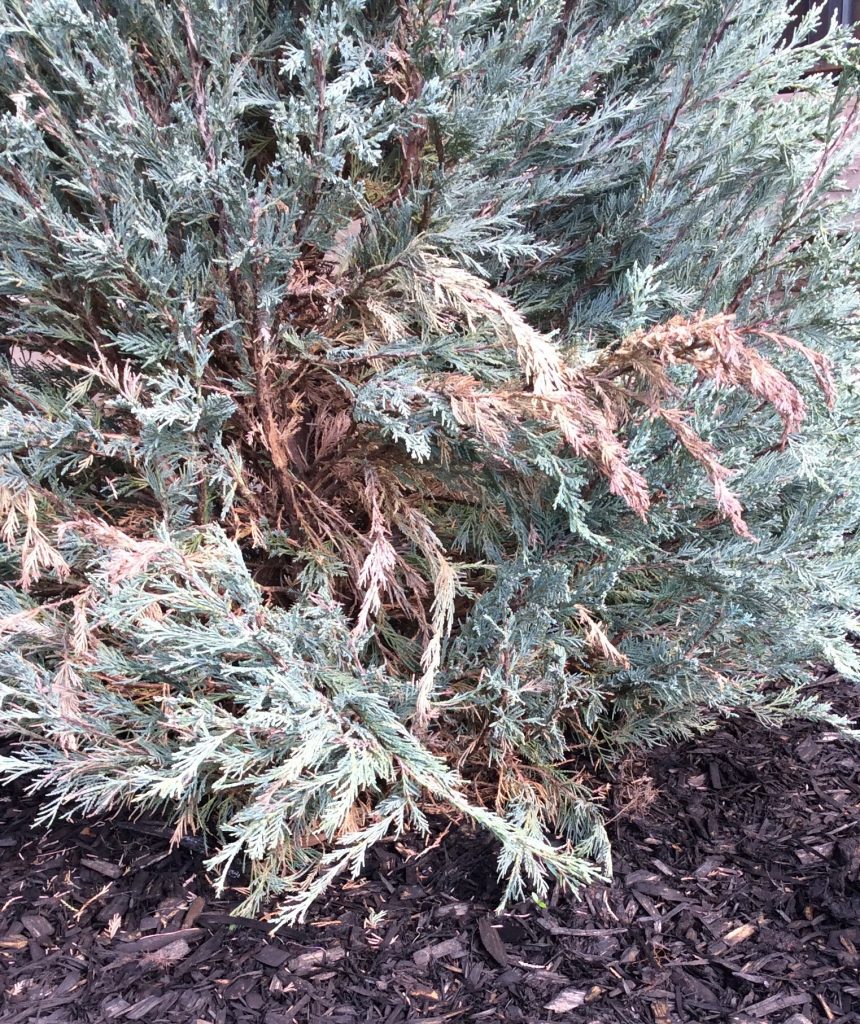
A month ago I planted a blue spruce and now branches are turning brown. The tree has been water regularly. Would appreciate your input on the cause
Thank you for contacting the Toronto Master gardeners concerning your Blue Spruce.
Problems with evergreen trees can be tricky to diagnose.Without knowing the site conditions it is difficult to know exactly what is the cause of your browning needles. Has there been any changes to the environment around the tree? Construction in your yard or a neighbours yard can affect your tree as its root.
You mention that you water your tree regularly, have you been watering it deeply and thoroughly as opposed to more frequent shallow watering. Depending on your watering practices your tree could be under or overwatered. Does your tree have proper drainage? Colorado blue spruce grows best in a sunny location with moist, well-drained soil. Was your tree properly planted?
Recommendations about planting trees and shrubs are evolving and incorporating new research findings. Past thinking has been to amend the soil before planting, by digging in either inorganic material, such as sand and gravel to loosen “heavy soil” and “improve drainage” or organic material, such as compost, leaf mould or manure to get your plants off to a good start.
Current thinking does not support these approaches. In fact, by adding inorganic materials such as sand or gravel to the bottom of your planting hole, you are in essence creating barriers to the unamended surrounding soil, which reduces the ability of air and water to move through the soil. This can result in a perched water table.
There is a wealth of information on our website listing the proper steps for planting a tree. The following information is from one of our archived posts:
“Begin by preparing the hole in the new planting space. A general recommendation is to create a hole 2-3 times the width of the tree’s root ball, and as deep as the root ball. The hole should be saucer shaped. Create a mound in the centre of the hole to support the root crown. Landscape Ontario’s Tree Planting Guide has a good diagram of what the hole should look like on page 43 Tree planting guide
Conserve the soil you remove when digging the hole to add back when planting. Unless the soil in your new location is of very poor quality, there is no need to add amendments. Research shows that trees and shrubs planted in the native soil of their planting location will establish roots better and grow more vigorously. You can read more about this here: Soil amendments.
If you can plant your tree on a cloudy, cooler day or in the early morning or later afternoon, this will help to decrease the stress of hot, scorching sun. Inspect the root ball by hand to look for damaged or defective roots and prune them away. If the roots are matted together or encircling each other, this is called being pot-bound. Gently separate and spread the roots out.
Now you can position your tree in the prepared hole. The tree should sit at the same height in the new hole as it did in the pot. Ideally, the root flare (where the stem / trunk transitions to the root system), should be at ground level. Roots transplanted too deeply can suffocate or may circle the stem, called girdling, which will shorten the life of the tree. Planting above grade level will cause the shrub to try out faster, make it less stable and more prone to frost heaving.
Refill the hole with the native soil you dug out to create it. When hole is about 2/3 full, water well to help the soil settle and remove air pockets. Continue to fill the hole and water again. You may want to apply an organic soil amendment such as compost and then add 2-4 inches (5-10 cm) of organic mulch (e.g., wood chips) around the tree base but at least 6 inches (15 cm) away from the trunk/stem.
There are a number of insects and diseases that could cause the problem that you are observing. Have you noticed any insects on your tree? The mose common disease of spruce trees is Cytospora Canker. Trees which are infected with Cytospora canker fungus show scattered branch die back, often started on the lower branches, however this is usually observed on older trees.
Have you noticed a change in needle colour? If yes, then it could be that your tree is infrected by the fungus Rhizosphaera This disease is first evident on the lower banches and gradually works it way upwards.
I am attaching a number of links which discusses potential causes of branch dieback and their control:
Common Diseases of Blue Spruce, Browing of Evergreens, Discoloued Needles. Sickly Spruces
Lastely, you may wish to contact a certified arborist for their advice. To find a certified arborist visit the International Society of Arboriculture’s searchable database here.
July 30, 2021

